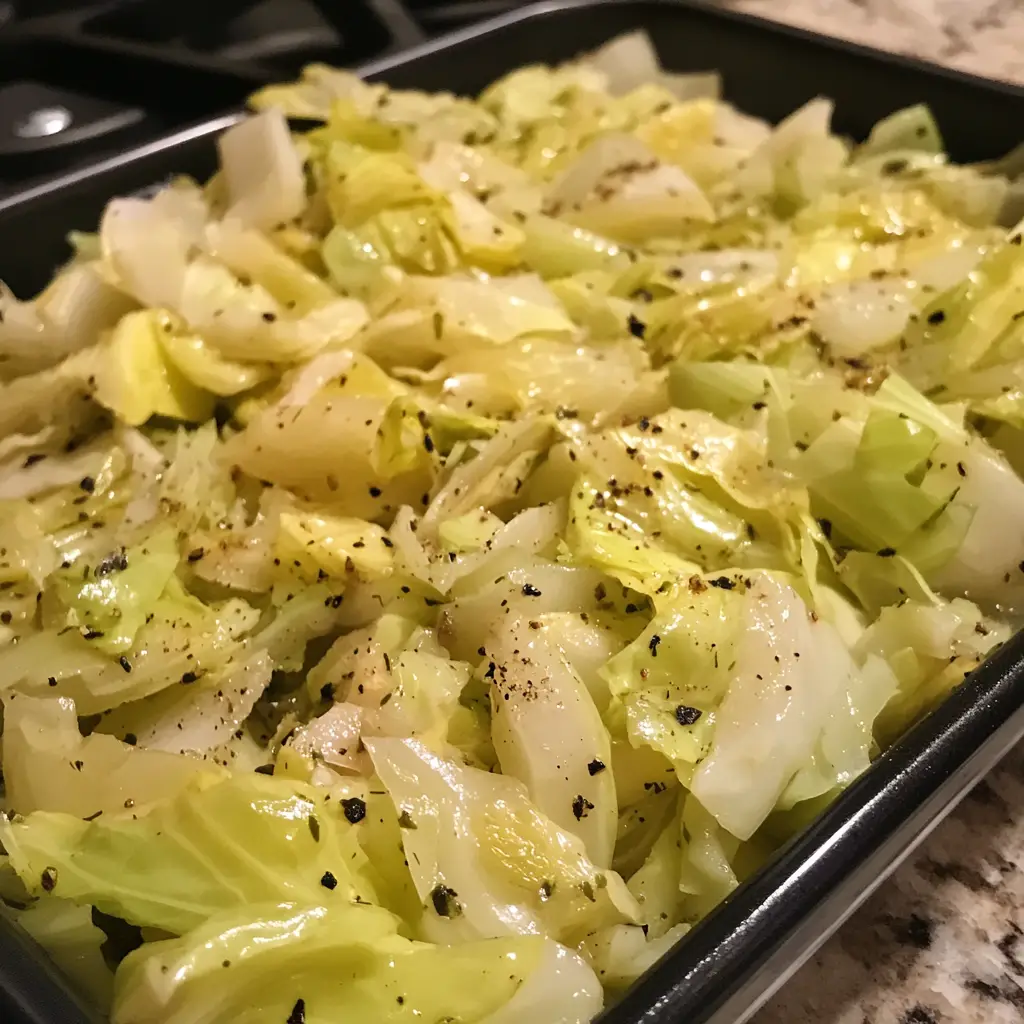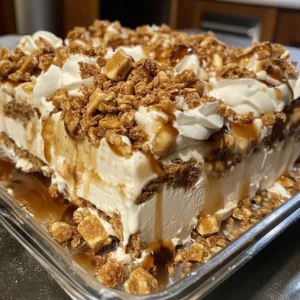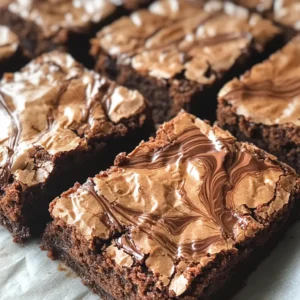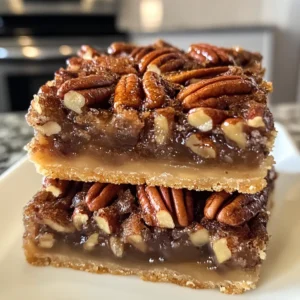Introduction to Sautéed Cabbage Recipe
Ah, sautéed cabbage! Just the thought of it brings back memories of my grandmother’s kitchen, where the aroma of caramelized cabbage would dance through the air, wrapping around me like a warm hug. I remember standing on my tiptoes, peering over the counter, eager to help her stir the pan. It was a simple dish, yet it held a world of flavor and comfort. Today, I want to share my sautéed cabbage recipe with you, a dish that is not only easy to make but also incredibly versatile.
What I love most about sautéed cabbage is its ability to transform from a humble vegetable into a star of the meal. Whether you’re looking for a quick side dish or a hearty main course, this recipe has got you covered. Plus, it’s a fantastic way to sneak in some greens without anyone noticing! I often find myself experimenting with different spices and add-ins, making each batch a little adventure in flavor.
In this recipe, I’ll guide you through the steps to create perfectly sautéed cabbage that’s tender yet slightly crisp, with a delightful hint of sweetness. You’ll learn how to bring out the natural flavors of the cabbage while adding your own personal touch. So, grab your apron, and let’s dive into the world of sautéed cabbage together!
Ingredients for Sautéed Cabbage Recipe
Before we jump into the cooking, let’s gather our ingredients! Having everything ready makes the process smoother and more enjoyable. I always find that when I have my ingredients prepped, I can focus on the fun part—cooking! Here’s what you’ll need for a delicious sautéed cabbage dish.
Main Ingredients
- 1 medium head of green cabbage (about 2-3 pounds), chopped
- 2 tablespoons of olive oil or butter (for that rich flavor)
- 1 medium onion, thinly sliced
- 2 cloves of garlic, minced
- Salt and pepper to taste
- 1 tablespoon of apple cider vinegar (for a tangy kick)
When choosing your cabbage, look for heads that feel heavy for their size and have crisp, vibrant leaves. Freshness is key! I often visit my local farmer’s market to find the best produce. The flavor of freshly harvested cabbage is simply unbeatable.
Optional Add-ons
- 1 teaspoon of caraway seeds (for a unique flavor twist)
- 1 tablespoon of soy sauce (for an umami boost)
- 1 teaspoon of red pepper flakes (if you like a little heat)
- Chopped bacon or sausage (for a heartier dish)
- Fresh herbs like parsley or dill (for a pop of color and freshness)
Feel free to get creative! I love adding a sprinkle of caraway seeds for a hint of earthiness or tossing in some crispy bacon for a savory crunch. The beauty of this sautéed cabbage recipe is its flexibility. You can easily adapt it to suit your taste or what you have on hand.
How to Prepare Sautéed Cabbage Recipe
Now that we have our ingredients ready, it’s time to roll up our sleeves and get cooking! I find that the process of preparing sautéed cabbage is not only straightforward but also quite therapeutic. Each step brings us closer to that delicious, caramelized goodness. Let’s dive into the steps together!
Step 1: Prepare the Cabbage
First things first, we need to get our cabbage ready. Start by removing any wilted outer leaves. Then, cut the cabbage into quarters and remove the core. After that, slice the quarters into thin strips. The thinner the strips, the quicker they’ll cook, and they’ll soak up all those lovely flavors!
Tips for Cutting Cabbage
- Use a sharp knife for clean cuts. A dull knife can make the process more difficult.
- Cut the cabbage on a stable cutting board to avoid any slips.
- If you’re unsure about your knife skills, don’t worry! Just take your time and enjoy the process.
Step 2: Heat the Pan
Next, it’s time to heat our pan. I usually opt for a large skillet or a wok because they provide plenty of space for the cabbage to sauté evenly. Pour in the olive oil or melt the butter over medium heat. You want the oil to shimmer but not smoke.
Tips for Choosing the Right Pan
- A non-stick skillet works wonders for sautéing, as it prevents sticking and makes cleanup easier.
- If you prefer a bit of a char, a cast-iron skillet is perfect for that! It retains heat beautifully.
- Make sure your pan is large enough to hold all the cabbage without overcrowding. This helps it cook evenly.
Step 3: Sauté the Cabbage
Once your pan is hot, it’s time to add the cabbage! Toss it in and stir it around to coat it in the oil or butter. I love to hear that sizzle! Cook the cabbage for about 5-7 minutes, stirring occasionally. You want it to become tender but still have a bit of crunch.
Tips for Perfect Sautéing
- Don’t rush this step! Let the cabbage cook slowly to develop those sweet, caramelized flavors.
- If you notice the cabbage starting to brown too quickly, lower the heat a bit.
- Feel free to add the sliced onions at this stage for extra flavor. They’ll soften and sweeten beautifully!
Step 4: Seasoning the Cabbage
Now comes the fun part—seasoning! Once the cabbage is tender, it’s time to sprinkle in some salt and pepper. I also like to add a splash of apple cider vinegar at this point for that tangy kick. It really brightens up the dish!
Tips for Flavor Enhancements
- Experiment with different spices! A pinch of red pepper flakes can add a delightful heat.
- For a savory twist, drizzle in some soy sauce or toss in caraway seeds.
- Don’t forget to taste as you go! Adjust the seasoning to your liking.
And there you have it! With these steps, you’ll create a sautéed cabbage dish that’s bursting with flavor and ready to impress. I can’t wait for you to try it!
Equipment Needed for Sautéed Cabbage Recipe
Before we get cooking, let’s make sure we have the right tools at our disposal. Having the right equipment can make all the difference in your sautéed cabbage experience. Here’s what you’ll need:
- Large Skillet or Wok: A spacious skillet or wok is essential for sautéing. It allows the cabbage to cook evenly without overcrowding. If you don’t have a large skillet, a regular frying pan will work too—just be mindful of the amount of cabbage you’re cooking.
- Sharp Knife: A good knife is crucial for cutting the cabbage into thin strips. It makes the process smoother and safer. If you’re not comfortable with a knife, a mandoline slicer can be a great alternative.
- Cutting Board: A sturdy cutting board provides a safe surface for chopping. If you don’t have one, a clean countertop will do in a pinch.
- Spatula or Wooden Spoon: You’ll need something to stir the cabbage as it cooks. A spatula or wooden spoon works perfectly for this task.
- Measuring Spoons: For precise measurements of oil, vinegar, and any spices you choose to add, measuring spoons are handy. If you don’t have them, you can use a regular tablespoon, just keep in mind that it may not be as accurate.
With these tools in hand, you’re all set to create a delicious sautéed cabbage dish. Remember, the joy of cooking comes not just from the ingredients but also from the experience of using your favorite tools. So, let’s get started!
Variations of Sautéed Cabbage Recipe
One of the things I adore about sautéed cabbage is its versatility. You can easily switch things up to keep your taste buds excited! Here are a few variations that I’ve tried and loved:
- Asian-Inspired Sautéed Cabbage: Add a splash of soy sauce and a sprinkle of sesame seeds. Toss in some grated ginger for an extra zing. This version pairs beautifully with rice or noodles!
- Spicy Sautéed Cabbage: If you’re a fan of heat, try adding diced jalapeños or a few dashes of hot sauce. The spice will elevate the dish and give it a kick!
- Sweet and Savory Sautéed Cabbage: Incorporate sliced apples or raisins for a touch of sweetness. The combination of sweet and savory flavors is simply delightful!
- Herbed Sautéed Cabbage: Fresh herbs like thyme or rosemary can add a fragrant twist. Just toss them in during the last few minutes of cooking for a burst of flavor.
These variations not only keep the dish fresh but also allow you to experiment with different cuisines. I love how a simple sautéed cabbage can take on so many personalities! So, don’t hesitate to get creative and make it your own.
Cooking Notes for Sautéed Cabbage Recipe
As I’ve journeyed through the world of sautéed cabbage, I’ve picked up a few cooking notes that can help elevate your dish. These little tips can make a big difference in flavor and texture, so let’s dive in!
- Don’t Overcrowd the Pan: If you add too much cabbage at once, it can steam instead of sauté. This can lead to a soggy texture. If you have a lot of cabbage, consider sautéing it in batches.
- Adjust Cooking Time: Depending on how tender you like your cabbage, you can adjust the cooking time. For a crunchier bite, sauté for a shorter time. For softer cabbage, let it cook a bit longer.
- Use Fresh Ingredients: Fresh garlic and onions can make a world of difference. Their flavors are more vibrant and aromatic, enhancing the overall dish.
- Experiment with Acidity: Besides apple cider vinegar, you can try lemon juice or balsamic vinegar for a different tang. Each brings its own unique flavor profile to the dish.
- Let It Rest: After cooking, let the sautéed cabbage sit for a few minutes before serving. This allows the flavors to meld together beautifully.
These cooking notes are like little nuggets of wisdom I’ve gathered over time. They help me create a sautéed cabbage dish that’s not just good but truly memorable. I hope they inspire you to make your own delicious version!
Serving Suggestions for Sautéed Cabbage Recipe
Now that we’ve created our delicious sautéed cabbage, it’s time to think about how to serve it! I love to pair this dish with a variety of meals, making it a versatile addition to my dinner table. Here are some of my favorite serving suggestions:
- As a Side Dish: Sautéed cabbage makes a fantastic side for roasted meats like chicken or pork. The sweetness of the cabbage complements the savory flavors beautifully.
- With Grains: Serve it over a bed of rice or quinoa for a hearty vegetarian meal. The grains soak up the flavors, making each bite delightful.
- In Tacos: Use sautéed cabbage as a filling for tacos! Add some grilled shrimp or chicken, and you’ve got a fresh and tasty meal.
- On a Sandwich: Pile it high on a sandwich with your favorite protein. The crunch and flavor of the cabbage add a wonderful texture.
- As a Salad Base: Let the sautéed cabbage cool and toss it into a salad with fresh veggies and a light vinaigrette. It adds a unique twist to your greens!
These serving suggestions not only enhance the dish but also allow you to enjoy sautéed cabbage in different ways. I often find myself experimenting with new pairings, and it’s always a hit at the dinner table!
Tips for Making the Best Sautéed Cabbage Recipe
As I’ve spent time perfecting my sautéed cabbage, I’ve gathered a few tips that can help you create the best version of this dish. These little tricks can elevate your cooking experience and the final flavor of your cabbage. Let’s dive into my favorite tips!
- Choose the Right Cabbage: While green cabbage is a classic choice, don’t shy away from trying red or Savoy cabbage. Each variety brings its own unique flavor and color to the dish.
- Mind the Heat: Cooking over medium heat allows the cabbage to caramelize beautifully without burning. If you notice it browning too quickly, lower the heat a notch.
- Layer Flavors: Start with sautéing onions and garlic before adding the cabbage. This builds a flavor base that makes the dish even more delicious.
- Finish with Freshness: Just before serving, toss in some fresh herbs or a squeeze of lemon juice. This brightens the dish and adds a lovely freshness.
- Don’t Rush It: Allow the cabbage to cook slowly. The longer it cooks, the sweeter and more flavorful it becomes. Patience is key!
With these tips in your back pocket, you’re well on your way to making a sautéed cabbage dish that’s not just good but truly exceptional. I can’t wait for you to try it!
Tips for Making the Best Sautéed Cabbage Recipe
As I’ve spent time perfecting my sautéed cabbage, I’ve gathered a few tips that can help you create the best version of this dish. These little tricks can elevate your cooking experience and the final flavor of your cabbage. Let’s dive into my favorite tips!
- Choose the Right Cabbage: While green cabbage is a classic choice, don’t shy away from trying red or Savoy cabbage. Each variety brings its own unique flavor and color to the dish.
- Mind the Heat: Cooking over medium heat allows the cabbage to caramelize beautifully without burning. If you notice it browning too quickly, lower the heat a notch.
- Layer Flavors: Start with sautéing onions and garlic before adding the cabbage. This builds a flavor base that makes the dish even more delicious.
- Finish with Freshness: Just before serving, toss in some fresh herbs or a squeeze of lemon juice. This brightens the dish and adds a lovely freshness.
- Don’t Rush It: Allow the cabbage to cook slowly. The longer it cooks, the sweeter and more flavorful it becomes. Patience is key!
With these tips in your back pocket, you’re well on your way to making a sautéed cabbage dish that’s not just good but truly exceptional. I can’t wait for you to try it!
Breakdown of Time for Sautéed Cabbage Recipe
Now that we’ve covered the ingredients and steps, let’s talk about the time it takes to whip up this delightful sautéed cabbage. I find that knowing the timing helps me plan my meals better, especially on busy days. Here’s a quick breakdown:
- Prep Time: 10 minutes
- Cooking Time: 15 minutes
- Total Time: 25 minutes
In just 25 minutes, you can have a delicious sautéed cabbage dish ready to serve! I love how quick and easy it is, making it perfect for weeknight dinners or when I have unexpected guests. Plus, the aroma that fills the kitchen while it cooks is simply irresistible. So, let’s get cooking and enjoy every minute of it!
Nutritional Information for Sautéed Cabbage Recipe
As a passionate home cook, I always pay attention to the nutritional value of the dishes I prepare. Sautéed cabbage is not only delicious but also packed with nutrients! Here’s a quick look at the nutritional information for a serving of sautéed cabbage made with the ingredients listed above:
- Calories: Approximately 100 calories
- Protein: 2 grams
- Fat: 7 grams (depending on the oil or butter used)
- Carbohydrates: 10 grams
- Fiber: 4 grams
- Sugar: 2 grams
- Vitamin C: 60% of the Daily Value (DV)
- Vitamin K: 85% of the DV
- Folate: 10% of the DV
These numbers can vary based on the specific ingredients and portion sizes you choose. What I love most about sautéed cabbage is that it’s low in calories while being high in vitamins and minerals. It’s a fantastic way to add more greens to your diet without sacrificing flavor. Plus, the fiber content helps keep you feeling full and satisfied. So, enjoy this nutritious dish guilt-free!
Frequently Asked Questions about Sautéed Cabbage Recipe
As I’ve shared my sautéed cabbage recipe with friends and family, I’ve noticed a few common questions pop up. It’s always great to clarify any doubts and help others enjoy this dish as much as I do! Here are some frequently asked questions about sautéed cabbage, along with my answers:
Can I use other types of cabbage for this recipe?
Absolutely! While green cabbage is the classic choice, you can also use red cabbage or Savoy cabbage. Each type brings its own unique flavor and texture, so feel free to experiment!
How do I store leftover sautéed cabbage?
If you have any leftovers (which is rare in my house!), let the sautéed cabbage cool completely. Then, transfer it to an airtight container and store it in the refrigerator for up to 3 days. You can reheat it in a skillet or microwave when you’re ready to enjoy it again.
Can I freeze sautéed cabbage?
Yes, you can freeze sautéed cabbage! Just make sure it’s cooled down before placing it in a freezer-safe container. It can last for about 2-3 months in the freezer. When you’re ready to eat it, thaw it in the refrigerator overnight and reheat it on the stove.
What can I serve with sautéed cabbage?
Sautéed cabbage pairs wonderfully with a variety of dishes! I love serving it alongside roasted meats, over grains like rice or quinoa, or even in tacos. It’s a versatile side that complements many meals!
Can I make sautéed cabbage ahead of time?
Yes, you can prepare sautéed cabbage ahead of time! Just cook it as directed, let it cool, and store it in the fridge. When you’re ready to serve, simply reheat it in a skillet. It’s a great way to save time on busy days!
I hope these answers help you feel more confident in making sautéed cabbage! If you have any other questions, feel free to reach out. Cooking is all about sharing experiences and learning together, and I’m here to help you every step of the way!
Conclusion on Sautéed Cabbage Recipe
In conclusion, sautéed cabbage is more than just a simple side dish; it’s a canvas for creativity and flavor. With its tender yet slightly crisp texture and the ability to absorb a variety of seasonings, this dish can easily become a favorite at your dinner table. I love how it brings warmth and comfort, reminiscent of family gatherings and cozy meals.
Not only is sautéed cabbage quick and easy to prepare, but it’s also packed with nutrients, making it a healthy addition to any meal. Whether you enjoy it as a side, a filling for tacos, or even as part of a hearty salad, the possibilities are endless. Plus, with the tips and variations I’ve shared, you can customize it to suit your taste and make it your own.
So, the next time you find yourself with a head of cabbage, remember this recipe. Embrace the joy of cooking and the delightful flavors that sautéed cabbage can bring to your table. I can’t wait for you to experience the magic of this dish—happy cooking!



